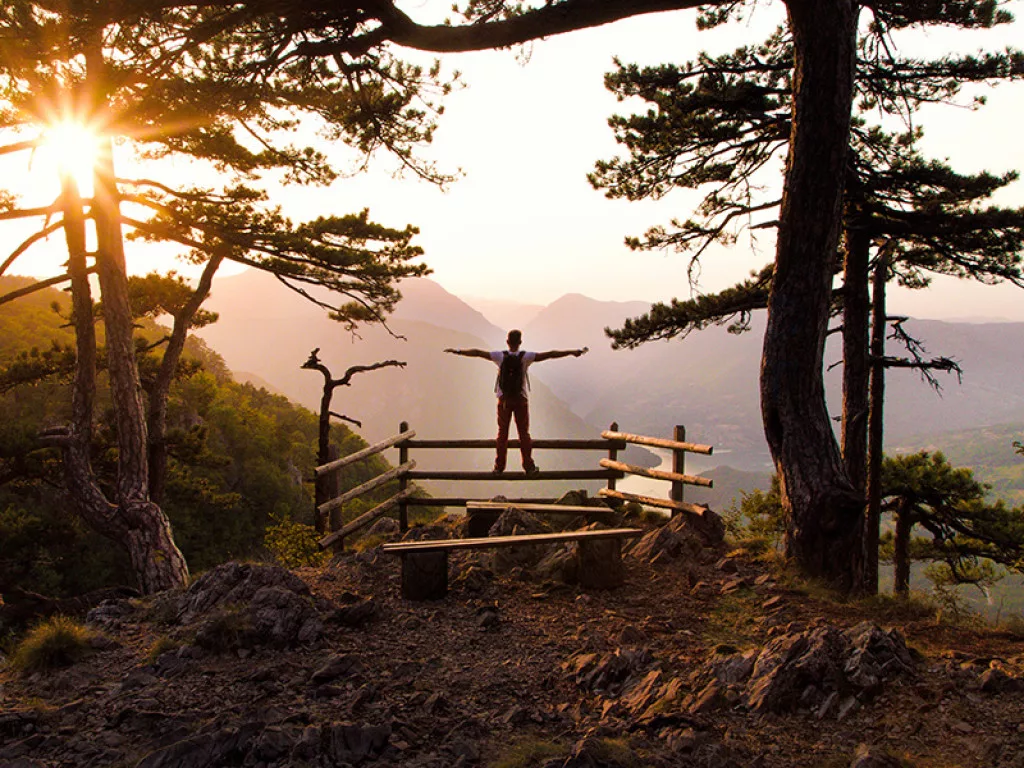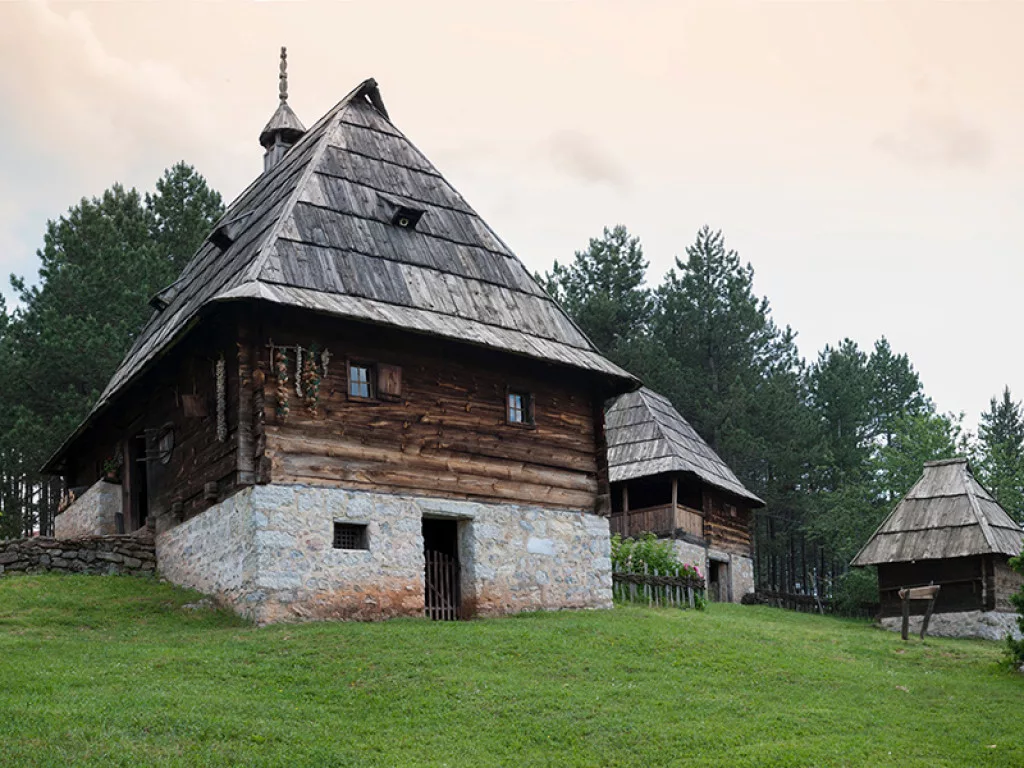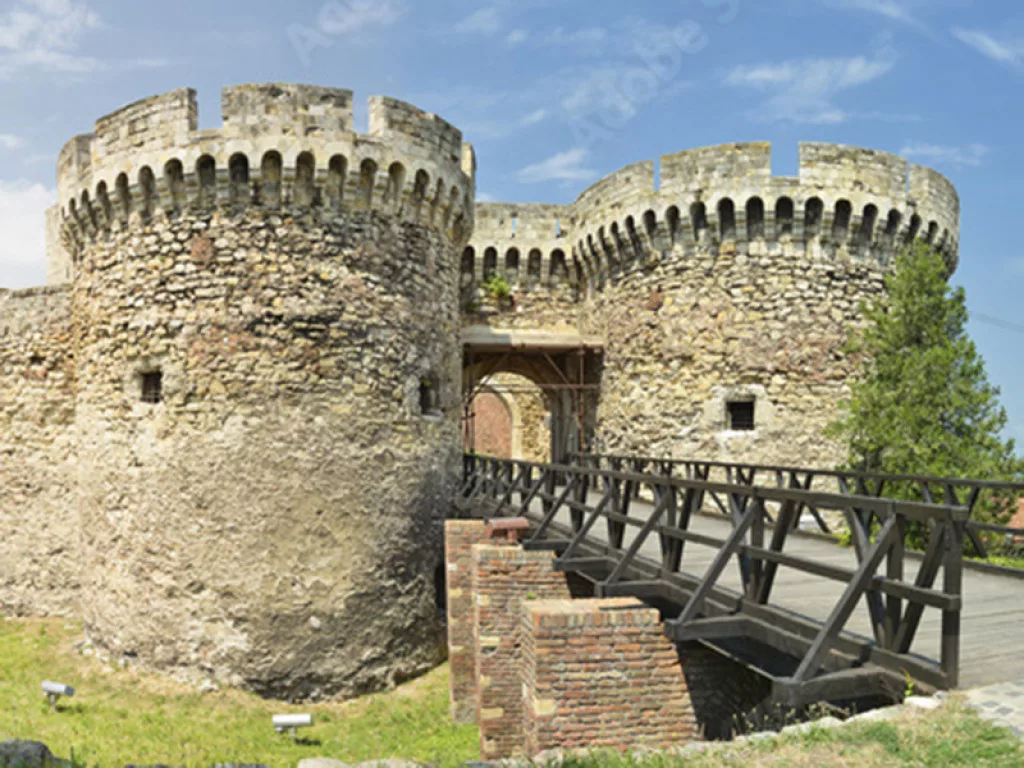Bouncing back strong from COVID-19, Serbia is a cultural crossroads home to majestic natural scenery, historic landmarks and unique hospitality.
SERBIA
Sprawling across the central part of the Balkan Peninsula in south-eastern Europe, the landlocked nation of Serbia is a tourist’s delight. This vast, diverse country combines the metropolitan charm and energetic buzz of historic cities, such as Belgrade and Novi Sad, with the unspoilt natural wilderness and jaw-dropping landscapes to be found within its five national parks.
The cultural melting pot of the capital Belgrade is the country’s most visited spot, offering a famous nightlife scene and world-renowned gastronomy. In the south, the city of Nis is a haven for art, history and culture, where genuine southern hospitality awaits.
Whilst the spoils of Serbia’s cities are not to be missed, the country is rare in presenting an opportunity to truly wander off the beaten track. Further afield, explore medieval monasteries and unique natural landmarks such as the Danube River Gorge and the cliffs of Kazan. Adventure abounds with endless opportunities for hiking, biking, rafting and kayaking in the natural playground of the Great Outdoors. Afterwards, unwind in historic wine regions and soak in thermal spas that date back to Roman times.
This small corner of Europe boasts an endlessly enticing plethora of experiences, and is compact enough to enjoy an authentic and varied vacation over the course of a few days. Whether a culture vulture or an adventure-seeker, you can guarantee that Serbia has something for you.

TOURISM INSIGHTS: NATIONAL TOURISM ORGANISATION OF SERBIA (NTOS)
Marija Labovic, CEO at the National Tourism Organisation of Serbia (NTOS), brings the latest news and developments on tourism in the region.
Q&A WITH MARIJA LABOVIC, CEO, NTOS
Firstly, could you briefly introduce us to NTOS – when were you founded and what is your vision and mission?
Marija Labovic, CEO (ML): NTOS was established in 1994 as the public body in charge of promoting Serbian tourism in domestic and foreign markets. Our activities are focused on positioning Serbia’s tourism products and exploring Serbia’s comparative advantages in terms of tourism, including its geostrategic position and its historical, cultural and natural identity.
Our vision is to achieve a recognisable image of Serbia as a tourist destination in domestic, regional and international markets, and to establish a marketing system that is harmonised at national, regional and local levels.
NTOS keeps abreast of modern trends in promotional activities and uses new communication and promotional tools, including e-marketing technology. In its future activities, NTOS will continue to strive to improve the promotional mix by implementing new communication and promotional tools used in online marketing, mobile applications, and content-sharing platforms.

“The crossed paths of East and West lead tourists through cultural and historical sights, but also mixed gastronomic tastes, passing from one region or city to another”
Marija Labovic, CEO, NTOS
Why, in your opinion, should someone visit Serbia in 2023?
ML: Serbia is in a specific surrounding of incredible natural beauty where the collision of East and West has left a unique mark on culture, history, the temperament of its people, gastronomy, music and architecture.
Serbia offers a unique and unrepeatable experience: unexplored nature, a capital city that vibrates with a modern spirit, smaller towns hidden from the crowds full of charm and warmth from days gone by, and rural households where you can experience the full meaning of what it means to be someone’s guest. Elsewhere, the country is rich with museums, monasteries, churches and other cultural monuments. And for those looking to explore the Great Outdoors, Serbia offers adventures in the canyons, cycling on the plains, and countless hiking and mountain trails you’ll want to return to.
Serbia is already well-known for its gastronomy, and last year we received the international recognition of the gastronomic quality from the prestigious Michelin guide – 14 Belgrade restaurants were selected with Michelin labels, celebrating their rich and diverse eating experiences. We are looking forward to the next selection in December this year.
In 2022, Novi Sad, our second biggest city, was proclaimed the European Capital of Culture for 2022. This is the first time that a city outside of the European Union has been awarded this great honour. As a result, this year, Novi Sad hosted a great number of cultural events, from exhibitions to concerts, to attract even more tourists to this beautiful multicultural city.
We are also extremely proud that, for the last 10 years, both Serbia as a country and the city of Belgrade have been among the top MICE destinations on the prestigious International Congress and Convention Association list.

What kind of travellers does your region appeal to most?
ML: The majority of international tourists visiting Serbia are from other countries in the region and our traditional source markets such as Germany. We are also seeing an increase in numbers from other European countries.
The destinations in Serbia most visited by international tourists are our biggest cities, led by Belgrade with over 60 percent of all international overnights, followed by our mountain resorts and our spa and recreational centres.
Serbia is a safe destination for all travellers and Serbian hospitality is unique. The crossed paths of East and West lead tourists through cultural and historical sights, but also mixed gastronomic tastes, passing from one region or city to another. The moderately continental climate gives Serbia all four seasons, so during the winter many skiing fans are attracted to our mountains, while the summer brings numerous festivals and is ideal for enjoying lakes and walks in almost untouched nature. Spring and autumn are best for exploring the cities and getting to know the extraordinary nightlife. Aside from all this, Serbia is rich in healing waters and even kings used to come to our famous spas. For all those looking for new experiences, Serbia is the ideal place.


What does Serbia have to offer in terms of sustainable or eco-friendly travel experiences?
ML: Serbia follows global trends in the development of tourism and the concept of eco-tourism is becoming more popular and important. It is recognised as the need for people to separate themselves, at least for a while, from everyday stress and to return to manual work and learning in a natural environment.
According to the research on the behaviour of domestic and foreign tourists conducted by the National Tourism Organisation of Serbia, 54 percent of domestic tourists cited nature as a motive for travelling in Serbia and eight percent cited outdoor activities. Meanwhile, 62 percent of our foreign guests listed cultural and historical heritage as a motive for visiting Serbia while nature accounted for 43 percent.
It is indisputable that Serbia has a preserved environment and that throughout the territory you can find amazing examples of traces that nature left for us to discover. One such example is Tara National Park, which constantly develops new products and tries to attract hikers, such as its latest programme centred on the photography and observation of wildlife, primarily the brown bear.
For years, the Zasavica nature reserve has been engaged in the improvement and development of its protected area through the breeding of old autochthonous breeds.
Elsewhere, the Bačko Podunavlje Biosphere Reserve has been placed on the World List of Biosphere Reserves, where tourists can get to know the characteristics of this area by rowing a boat or observing and photographing wildlife. The Uvac nature reserve also has opportunities to observe griffon vultures and kayaking excursions along its meandering waterways. Here you can find rural households with accommodation facilities, which have excellent conditions for the development of eco-tourism.
Are you optimistic about the recovery of tourism in Serbia, particularly with regards to the COVID-19 pandemic?
ML: Tourism, as one of the strongest global sectors has suffered the most due to the pandemic, and the situation in Serbia is no different. In 2019, Serbian tourism reached a historic record of almost two million international tourists with over four million overnights. These numbers of visitors and overnight stays were the result of the year-on-year double-digit growth that started back in 2013 and was influenced by significant tourism infrastructure development, the rise of the service quality, the diversification of tourism products and intensive promotional campaigns, accompanied by strong governmental support and the recognition of tourism as one of the key drivers of the economy.
We are very proud to confirm that tourism in Serbia witnessed a strong recovery this year and exceeded its record 2019 results! Comparing the latest available data, the total number of tourist overnights has increased by 19 percent over 2019, while the number of foreign tourist overnight stays is up an incredible 19 percent compared to the pre-pandemic period.
OUTLOOK RECOMMENDS
For a comfortable stay in New Belgrade…
The Hyatt Regency Belgrade is the preferred upscale hotel for leisure and business travellers, conveniently located in the heart of the capital’s main business and entertainment district. Close to the city centre and well connected to Belgrade airport, enjoy long walks along the Sava River, have fun in the largest shopping mall in the city, or just relax at the hotel’s Club Olympus Fitness facilities. Boasting on-site amenities including the Metropolitan Grill, Tea House and the exclusive Regency Club, the Hyatt Regency is also the ideal option for a family-friendly stay.

IN FOCUS: NOVI SAD
Serbia’s second biggest city, Novi Sad was proclaimed as the European Capital of Culture for 2022. Situated in Northern Serbia on the scenic banks of the river Danube, Novi Sad’s origins date back to 1694 when a colony was formed here by Serb merchants. The city is often referred to as ‘the Serbian Athens’ and ‘the Gibraltar of the Danube’.
The iconic symbol of Novi Sad is the formidable Petrovaradin fortress, which dates back to the Middle Ages and was used as part of the military frontier during the Ottoman Empire.
A visit here offers unparalleled insight into the development of the city from the first half of the 18th century through to the mid-20th century. Every year, thousands descend on this spot for one of Europe’s biggest events – EXIT Festival, which gathers renowned musicians from around the globe.
It is often said that time passes more slowly in Novi Sad, thanks to the city’s famously laidback vibe. Awarded the title of ‘European Youth Capital’ in 2019, its easy-going spirit and happening nightlife scene are a magnet for younger travellers. Home to great music, food and a rich cultural diversity, many consider Novi Sad to be the gem in Serbia’s crown.


LANDMARK ATTRACTIONS
Belgrade Fortress
Known in Serbian as Kalemegdan, this formidable citadel has been destroyed over 40 times throughout its rich history. The fortress as you see it today is the result of 18th century Austro-Hungarian and Turkish reconstructions. As the original landmark around which Belgrade developed, a visit here is highly recommended for any travellers interested in Serbia’s history.

Kopaonik
As Serbia’s largest mountain massif, Kopaonik attracts just as many visitors in the winter months as it does in summer, whether for skiing or to enjoy a variety of hikes and mountain sports amidst awe-inspiring scenery. ‘Kop’ owes its nickname of the ‘sunshine mountain’ to the 200 days of sun that the national park typically enjoys every year.

Studenica Monastery
Dating back to the 12th century, Studenica is considered the mother of all Serbian Orthodox monasteries. Its grounds boast pristine marble churches, Byzantine frescoes, and are the final resting place of Stefan Nemanja, saint and founder of the Serbian empire. Nearby, visit the hermitage of St Sava where a complex of monks’ cells has been built into the cliffside.

GETTING THERE AND AROUND
International tourists will typically arrive in Serbia at Belgrade Nikola Tesla Airport (BEG), located 20 kilometres (km) outside of Belgrade. If visiting the southern regions, it is recommended to fly into Nis Constantine the Great Airport (INI), on the outskirts of Nis, or Morava airport in the city of Kraljevo.
To travel around the country, rental cars are the best option, especially if wanting to reach more remote destinations. Otherwise, Serbia is well-connected with a practical and accessible network of coach and bus services.
























